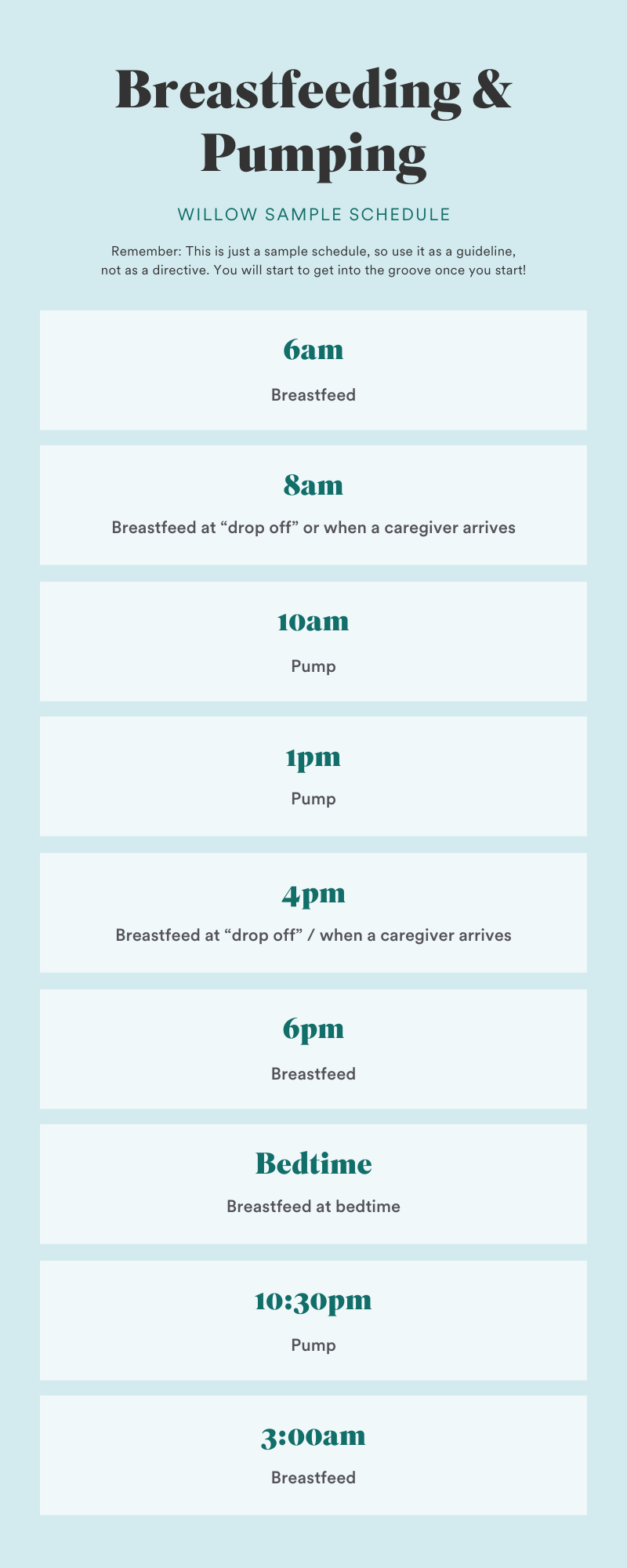Pump and Feed Baby at the Same Time
How to Combine Breastfeeding & Pumping
Find a schedule that works for you!


This article was written in partnership with our International Board Certified Lactation Consultant, Wendy Wright, who loves working side by side with moms and babies to find that secret sauce! She's also a mother of two and the Mom Experience Lead at Willow Pump.
We're living in a modern, fast-paced, frenetic, non-stop, always-on world. We're inundated with information—especially as new parents! We know you've already Googled it: the best way to feed, how long to feed, when to feed, why to feed and it can truly be exhausting. There are many reasons moms choose to combine breastfeeding and pumping and the choice is personal. We've all heard the guidelines (six months to a year) and we all know that breastfeeding is great for our children. But the reality is… reality. So, sometimes you choose both. If you want to breastfeed and pump milk for your baby, here's your Willow-approved toolkit to get it done.
The Top Reasons Moms Choose to Breastfeed and Pump
.jpg)
"Something we hear often is that moms want to combine breastfeeding and pumping, but getting started, setting up a schedule and diving in head first feels like a lot when you're already dealing with new mom stress," says Wendy Wright, International Board Certified Lactation Consultant. "The first thing to know is that there are myriad reasons why a parent might choose to do both." Here's a few of them:
-
You're concerned about your milk supply, so you want to try pumping to increase your production.
-
You want to have greater flexibility in your life.
-
You're about to return to work or other obligations and need to be away from your baby for longer periods of time.
-
You'd like to involve a partner in feeding.
-
There's an underlying medical issue that prevents exclusive breastfeeding (i.e. tongue tie or a yeast infection)
What You Need to Breastfeed & Pump
To get started, you'll need to first make sure you have the right equipment to pump and breastfeed. Obviously, breastfeeding seems a bit more straight forward–after all, the equipment is, well, attached to you! However, there are a few tools that will make it a bit more comfortable.
Breastfeeding Tricks of the Trade
-
Invest in a good nursing pillow. It will help support you and your baby so that focusing on getting a latch is easier. It also frees up your hands so you can multitask (or just relax).
-
Nipple cream or coconut oil. Prevent discomfort and chapped nipples from the get-go.
-
Nursing top or bra. Easy access is key and finding one that works right for you will pay off over the next weeks and months.
-
Sit in a warm bath or environment before nursing. This may help stimulate your let-down reflex. Plus, it's a great way to relax!
-
Learn bottle feeding techniques, before nursing. There are different ways to introduce bottle feeding that will encourage babies to continue breastfeeding simultaneously.
Breast Pumps & Accessories
Ah, the breast pump. With so many options on the market, it's important to consider what will work best for you and your lifestyle. Here are the three most common options available to you.
-
Electric breast pumps : Ye ol' breast pump. Electric breast pumps have been the standard for … years. You've seen them, your friends have used them, and they're covered by (most) insurance companies. Yet, they're noisy, bulky, have a ton of pump parts, and require you to be connected to the wall. Talk about a let-down.
-
Wearable breast pumps: Wearable breast pumps, like the Willow Pump, are new to the market and are reinventing the standard and expectation moms have for pumping. They're quiet, portable, fit inside your bra, and offer you complete freedom and mobility.
-
Manual breast pumps: Manual breast pumps require no power. Instead, you use your hand to pump and express the milk. If you only foresee yourself pumping once or twice a week, the manual breast pump may be adequate. Many women use them to relieve engorgement or to catch milk that's expressed from the breast not occupied by your baby while they're nursing.
-
Cleaning wipes: While on-the-go, it's easy to wipe down your pump with a quick wipe to ensure everything stays clean and germ-free.
-
Bra pads: Bra pads or nursing pads protect your clothes from any leaking that may occur before or after your pumping session.
-
Cold storage bag: It's true that breast milk is okay at room temperature for up to four hours. Yet, if you're out and about without access to a refrigerator, you may want a small cold storage bag to keep your milk cool.
How to Time Your Feeding & Pumping to Maximize Your Output
The best way to move forward with breastfeeding and pumping is to create a flexible routine that will fit into your varying schedule. This way, you can ensure you're pumping enough milk for your baby. Pumping regularly will help prevent your milk supply from dwindling when you're away from your baby.
"Breastfeeding, breast pumping or the combination of the two are so individual and will most likely change from month to month throughout this new motherhood journey. The practicalities of providing breast milk look different for every mom I work with yet, we all share the same goal of nourishing our infants. There is no right way, there is your way; please consider this guidance and incorporate only what supports your journey right now," says Wendy.
Willow Sample Schedule: Breastfeeding and Pumping
Remember: This is just a sample schedule, so use it as a guideline, not as a directive. You will start to get into the groove once you start!

The most common guideline for feeding your baby is every 2 to 3 hours which means you'll need to pump at this same cadence while you're away. If you're not working outside of your home and still wish to build a milk supply, try pumping after or during each breastfeeding session for 10-15 minutes. Stick to this schedule for a few weeks—you'll start to see patterns and habits develop which will make it easier.
Ask an LC: Tips for Breastfeeding & Pumping
We know that breastfeeding and pumping come with a ton of questions. And unfortunately, it seems everyone has a different answer. Allow us to give you some much-needed clarity as you start this rewarding journey.
How Soon Should I Pump After Breastfeeding?
Pumping after you breastfeed is a great way to boost your supply. There is no need to wait before pumping, pump when it is most convenient for you. Just understand that immediately after a breastfeeding session, you'll get less from your pumping session. That's okay, it's the empty breast and the stimulation of the nipple that tells the breast to make more milk. It's more important that you pump (stimulate) than time each session perfectly for greatest output.
How Long Should I Pump and Breastfeed?
The length of a breastfeeding session will depend on your baby. Younger babies feed longer, older babies are more efficient. Some babies will latch and finish within 10 minutes and others will require up to 30 minutes or longer. You should plan to spend around the same amount of time pumping, around 15 to 30 minutes. You'll begin to notice when your milk flow slows after a few pumping sessions. Once this occurs, you can stop.
Can You Pump and Breastfeed at the Same Time?
Yes. It will take some practice to get this right, however. You can let your baby nurse on one side and pump the other side simultaneously. Just remember to start your baby's next nursing session on the side they didn't nurse from previously as a breastfeeding baby is capable of emptying the breast more than any mechanical pump.
Will Breastfeeding & Pumping Together Confuse My Baby?
Some babies may develop nipple confusion when fed by both the bottle and the breast. This happens because the bottle nipple allows milk to flow more freely with less effort from the baby. Here are some suggestions for reducing nipple confusion or a fast flow preference:
-
Try to delay bottle feeding until your baby has established their breastfeeding technique and pattern, which occurs around 4 weeks. If you need to start pumping to build supply before then, do so and freeze the milk.
-
Try slow flow nipples when using a bottle. Using Stage 1 or Newborn nipples throughout the breastfeeding journey will also help slow the flow so the baby does not develop a preference for bottles.
-
Pace feeds. Whenever your baby is offered a bottle, the feeding should be paced. A bottle feeding should take the same amount of time as a breastfeeding session. Keeping the bottle horizontal and allowing the baby the opportunity to suckle on the bottle nipple in between her suck/swallow/breathe pattern will extend the feeding, avoiding flow preference with the bottle.
-
Try to adapt to a schedule (like the one above) to allow you to have ample breastfeeding time and will ensure that your baby is given both a bottle and breast daily.
Should I Be Worried If I Don't Produce Much Milk While Pumping?
If you are breastfeeding and pumping, you shouldn't be concerned about not pumping much during a session, especially if you pump right after a breastfeeding session. A full milk supply for babies 0-6 months is considered 24-26 ounces per 24 hours or about an ounce per hour. If you pumped or breastfed at noon and then pumped at 3pm, expect 3 ounces total. If you get less, you may need to pump more frequently. Small fluctuations are normal and letting down for a pump is more challenging than letting down while you're nursing. Remember, you know your body best.
How to Store Your Breast Milk
If you're pumping and storing your breast milk for future use, here are some tips!
-
Keep bag ounces low: Once you thaw your milk, you can't refreeze it. So, keep the number of ounces in each storage bag low and aligned with how much baby needs per feeding. We recommend 4 ounces or less.
-
Date your milk storage bags: You'll want to use the older bags of milk first. Make it easy by labeling your storage bags with the date using a permanent marker. Then, store your milk bags with the date facing towards you in a freezer-safe container for easy grab-and-go.
-
Don't combine freshly expressed milk with frozen milk: Place freshly pumped milk into the fridge to chill before placing it into a freezer bag. Only combine milk when pumped on the same day, and never add liquid milk to frozen milk to prevent premature warming. This prevents the new milk from thawing the frozen.
Willow is a quiet, wearable breast pump that makes pumping easy for all mamas. It's the perfect way to ensure seamless pumping for you and your baby. To learn more about Willow, visit us.
Pump and Feed Baby at the Same Time
Source: https://onewillow.com/blog/how-to-combine-breastfeeding-pumping/
0 Response to "Pump and Feed Baby at the Same Time"
Post a Comment